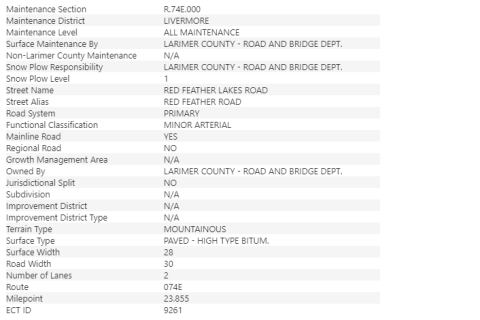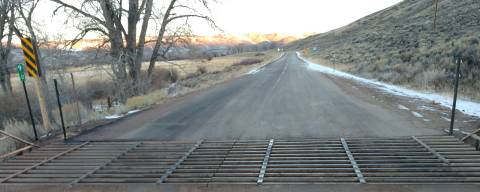FAQS
FAQs
-
Who maintains my road?
Our Road Information Locator provides detail on ownership and maintenance of roads within the county. General instructions to the system are below:
You can navigate and zoom in on an area using your mouse or search by an address.
To search by address:
- In the Search box in the top right corner, type in your address. As you type, there will be a drop down of addresses that contain your search criteria.
- Click on appropriate address. If you are unsure of exact address, but know the road, type the road name and select an address on the road. For a numbered county road (ex. CR 47), type “County Road 47” in search box. On the left side of the screen, you will see results.
- Click on the arrow to the right of Tax Parcels
- Once parcel information appears, click on the bullseye symbol. This will zoom in on the property.
After the road is in view on your screen, in the Layers tab, click on Road Maint.
Click on the road in the map, an informational box will appear that has maintenance information

-
What do I do if Larimer County Road and Bridge does not maintain my road?
If it is a private road, the landowner(s) are generally responsible for the maintenance.
If it is a public, non-county maintained road, check with your HOA (Home Owners Association) or see if there is a PID (Public Improvement District) for your road. Information on existing PIDs or forming a new PID can be found here.
If you have a question regarding your subdivision maintenance, the history and list of county maintained subdivisions can be found here.
-
Who is responsible for the culvert under my driveway?
Larimer County Road & Bridge practice has been that we will maintain and replace them after the initial installation when necessary to protect the adjacent county-maintained roadway.
-
Do you do the maintenance on Highways and Interstates such as I-25 and Highway 14/Highway 34?
No, that would be the Colorado Department of Transportation (CDOT): (970) 350-2368
-
When will my road get plowed?
We provide five levels of service for roads that Larimer County has responsibility for plowing. These levels provide the appropriate response and priority to first meet the needs of school bus and commuting traffic and mail routes with daily mail service. We also provide nighttime snow and ice control on specific roads. For questions on what level of service your road receives, please go to our Road Information Locator. Our Snow and Ice Control Policy details the various level of service definitions and hours of service.
-
Can you grade my road? It has pot holes in it. It is wash boarded. It is rough.
When a request for maintenance is received, the condition of the road will be assessed and prioritized in the schedule based on how it compares to the condition of the other non-paved roads in the system. The road will be maintained as soon as possible.
-
What is the process you use to grade the roads?
Please refer to the Non-Paved Roads page, accordion tab labeled "Road Grading Process."
-
Is the chip seal on my road complete?
What does your road look like?
- No work, but freshly swept - No, we are just beginning.
- Lots of loose chip/rock on surface - No, we haven't completed the second round of sweeping.
- It's got new chip, but it isn't black - No, we need to fog seal.
- It's black - Yes, the process is complete, if in a subdivision.
- It's black, but doesn't have striping - On mainline roads, chip seal is complete once the road has been striped.
-
Who do I notify about a dead animal on the road?
If the road is maintained by Larimer County Road and Bridge, we will handle as follows:
If the animal is a small, domestic animal, contact the NOCO Humane at 970-226-3647 or report online.
If there is an animal on the roadway that is impeding traffic, call our office at 970-498-5650 and we will dispatch the appropriate crew to remove from roadway. If during non-business hours, please contact Sheriff's office dispatch at 970-416-1985 and they will contact our On-Call Manager.
If the animal is on the side of road and not impeding traffic, you can call our office at 970-498-5650, or report the issue in our Citizen Request Portal. We will do our best to remove the animal the next time we have a crew working in the area.
-
A sign on my road is down or damaged, who do I call?
Stop Signs, Yield Signs and Railroad Crossing Signs - during regular business hours, please call our office at 970-498-5650. During non-business hours, please call Sheriff's office dispatch at 970-416-1985 and they will contact our On-Call Manager.
All other Signs, report the issue in our Citizen Request Portal or call our office phone at 970-498-5650 and leave a message.
-
I want the speed limit on my road changed or a new sign put up on my road.
Larimer County reviews the need for signs based on traffic studies. If you feel like you have a need, please visit our traffic-signs webpage to learn about the process for requesting a new or change to an existing sign.
-
What are you doing with the material that is being cleaned out of the ditch?
We can give it away when it makes business sense. If you would like the material, we keep a list of interested people. Please call our Structures Manager at 970-498-5672.
-
Why do you treat gravel roads and what is the chemical used?
Please refer to the Non-Paved Roads page, accordion tab labeled "Dust Suppressant."
-
How do I get the dust suppressant chemical you put on the road off my car?
Normally, the product will wash off with a typical car washing.
-
How long does it take for the dust suppressant to dry after you apply it?
There are many factors such as temperature, wind, cloud cover and humidity that determine how long the dust suppressant takes to cure. On a typical summer day, it takes from 2-3 hours for the treatment to fully cure.
-
A county vehicle caused damage to my vehicle or property
If you have been involved in an auto related incident involving the County, please contact TRISTAR Risk Management, the third-party claim administrator for Larimer County. TRISTAR Risk Management can be reached at 1-855-495-1554 or via email Denver.FNOL@tristargroup.net
If you have further questions, there is more information provided by our Risk Management Department.
-
Where can I find a printable map of the County?
The following link provides various printable maps of Larimer County:
-
What is this metal grate that goes across the road (cattleguard) and why is it used?

